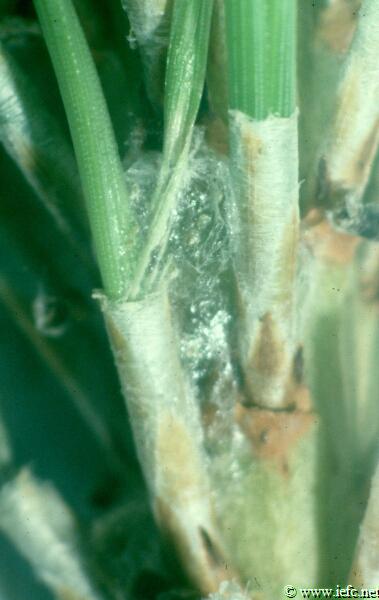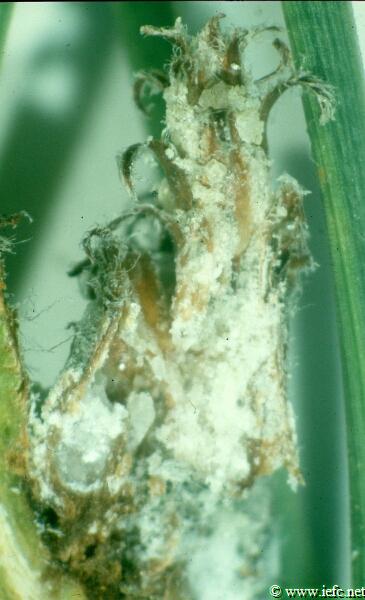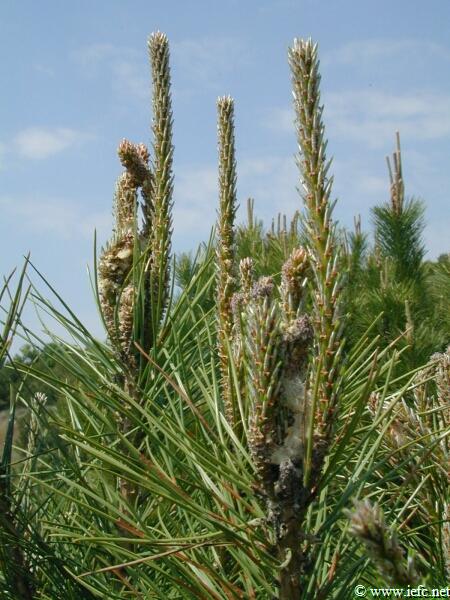European pine shoot moth
Rhyacionia buoliana (Denis & Schiffermüller) (Lepidoptera, Tortricidae)
Synonym: Evetria buoliana
Host tree
Many pine species. Scots pine (Pinus sylvestris) and Monterey pine (P. radiata) are particularly prone to attacks. In addition, sporadic attack has been observed on Douglas fir (Pseudotsuga menziesii)
Identification
- In summer, yellowing of the needles in the upper part of the twigs.
- In summer, presence of small refuges webbed between and around the bud clusters and the surrounding needles, coated with resin and frass (Photo 1).
- From June to September, young, light-brown caterpillars with a black head within the needles and buds.
- In spring, noticeable resin accumulation, ‘pitch masses’, at the base of developing shoots, mainly in the upper whorls.
- From March to July, presence of older caterpillars inside the growing shoots or in the pitch masses. Older caterpillars are brown to purplish-brown, up to 2 cm long, with a black head and shield (Photo 3). Caterpillars of the Pine tip moth (R. duplana) are smaller and more red- or orange-like in colour; they are found boring from the tips of shoots downwards.
- Presence of forked terminal shoots.
Damage
- Buds and developing shoots are mined and killed or damaged (mainly in young trees).
- Economic losses due to stem distortions: forked, double and ‘post-horn’ stems, dwarf and bushy trees.
- In Stone pine seed orchards, losses in the cone crop due to the killing of the flower bearing shoots and the larvae attacking the cones.
Biology
- There is one generation per year.
- Moths fly between May and August (about 2 months in each site).
- Eggs are laid singly or in pairs on shoots, buds and needles.
- In summer, larvae first mine at the needle bases, then move to mine the buds, where they overwinter from autumn to spring.
- Older caterpillars mine the growing shoots during spring, in many occasions, the developing cones are also attacked; pupation occurs inside the pitch masses (late spring/early summer).
- Outbreaks may last for several years in stressed stands; tree response and natural enemies are the main factors regulating populations.
Risk factors
- Insect pest of the early ages of pines, typically monocultures trees of 3 to 20 years, in sunny, open stands; less abundant in mountain areas.
- Frequently associated to environmental conditions promoting weakening of the trees (soil water stress, summer drought, hard and infertile soils).
- Plantations of exotic, fast growing pines, may also be severely affected.
Distribution
- All of Europe until Ural Mountains. Introduced in North and South America.
Pest management
Monitoring
- In spring, observations of attacked trees with growth distortions or with presence of pitch masses on the shoots.
- Pheromone trapping (late spring to mid summer) to assess flight period.
Preventive measurements
- Promote healthy growth by choosing tree species suitable to the site.
- Avoid sensitive species and monocultures of even-aged trees.
- Favour a higher stand density in susceptible stands.
Curative control
- In most countries, there are no insecticides registered against this pest.
Climate change
- Attacks by R. buolina occur mostly on stressed trees, including by drought. Thus, all regions where pine species will be increasingly stressed by soil water stress and summer drought are likely to suffer more from R. buolina, and vice versa.
- The distribution is limited northwards by minimum temperatures below -28]C. Thus, it can be expected that rising temperatures will allow the moth to occur and outbreak further north.




